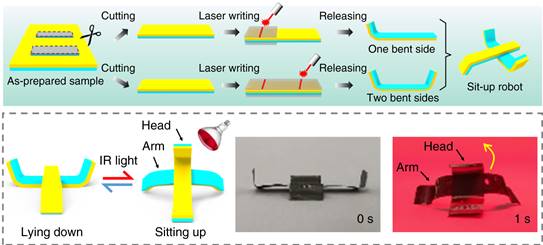A research group led by Prof. CHEN Tao at the Ningbo Institute of Materials Technology and Engineering (NIMTE) of the Chinese Academy of Sciences (CAS), brought the asymmetric elastoplasticity of stacked graphene assembly (SGA) into full play, contributing to the SGA/polyethylene (PE) bilayer actuators with excellent controllable morphing capability. The study was published in Nature Communications.
Soft robotics, which can achieve complex morphing behavior, have aroused increasing attention of scientists. However, current soft robotics mainly relies on pneumatic networks embedded in elastomeric rubbers, therefore most of them need to be tethered to external power sources and control systems, which greatly restrains their practical applications.
Developing programmable untethered soft robotics still remains challenging. To address this issue, the researchers at NIMTE applied the asymmetric elastoplasticity of SGA under tension and compression. The SGA was transferred onto a PE film, and the resulting SGA/PE bilayer showed swift morphing behavior according to the variation of the surrounding temperature.
Through the applications of patterned SGA and localized tempering pretreatment, the initial configurations of thermal-induced morphing systems were able to be programmed as needed.
The prepared SGA/PE bilayer film can be applied to the development of diverse thermal-responsive or light-responsive actuators including sit-up robots, artificial iris, and artificial water lily, etc.
Morever, the tempered SGA/PE bilayer will spontaneously curl into a roll, thus can achieve rolling locomotion under lateral infrared lighting, yielding an untethered light-driven motor.
The study has presented a facile and cost-effective strategy for creating programmable untethered soft robotics, and shed light on the development of 2D material-based smart materials and structures.
This work was supported by the Natural Science Foundation of China (No. 51803226, 51573203, and 11772283), the Bureau of International Cooperation of Chinese Academy of Sciences (No. 174433KYSB20170061), Key Research Program of Frontier Science, Chinese Academy of Sciences (No. QYZDB-SSW-SLH036), NSFC-Zhejiang Joint Fund for the Integration of Industrialization and Informatization (No. U1909215), Postdoctoral Innovation Talent Support Program (No. BX20180321), China Postdoctoral Science Foundation (No. 2018M630695), General Research Fund (PolyU 152064/15E, PolyU 5293/13E) from Hong Kong RGC, and Ningbo Scientific and Technological Innovation 2025 Major Project (No. 2018B10057).

Fig. Typical morphing systems assembled from basic morphing units of SGA/PE bilayer (Image by NIMTE)
Contact
HUANG Ye
Ningbo Institute of Materials Technology and Engineering
E-mail: huangye@nimte.ac.cn

